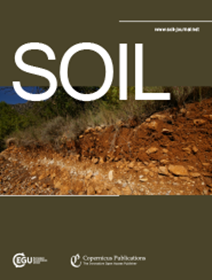Modeling of greenhouse gas emissions from paludiculture in rewetting peatlands is improved by high frequency water table data
IF 5.8
2区 农林科学
Q1 SOIL SCIENCE
引用次数: 0
Abstract
Abstract. Rewetting drained peatlands can reduce CO2 emissions but prevents traditional agriculture. Crop production under rewetted conditions may continue with flood-tolerant crops in paludiculture, but its effects on greenhouse gas (GHG) emissions compared to rewetting without further management are largely unknown This study was conducted between 2021 and 2022 on a fen peatland in central Denmark. At the study site, three harvest/fertilization management treatments were implemented on Reed Canary Grass (RCG) established in 2018. Measurements of CO2 and CH4 emissions were conducted biweekly using a transparent manual chamber connected to a gas analyzer and manipulating light intensities with four shrouding levels. Although this was a rather wet peatland (−8 cm mean annual WTD), the site was a CO2 source with a mean net ecosystem C balance (NECB) of 6.5 t C ha−1 yr−1 across treatments. Model simulation with the use of high temporal resolution water table depth (WTD) data was able to better capture ecosystem respiration (Reco) peaks compared to the use of mean annual WTD, which underestimated Reco. Data on pore water chemistry further improved statistical linear models of CO2 fluxes using soil temperature (Ts), WTD, ratio vegetation indices and PAR as explanatory variables. Significant differences in CO2 emissions and water chemistry parameters were found between studied blocks, with higher Reco corresponding to blocks with higher pore water nutrient concentrations. Methane emissions averaged 113 kg of CH4 ha−1 yr−1, equivalent to 11.3 % of the total carbon emission in CO2 equivalents. Because of large heterogeneity among the experimental blocks no significant treatment effect was found, however, the results indicate that biomass harvest reduces GHG emission from productive rewetted peatland areas in comparison with no management, whereas on less productive areas it is beneficial to leave the biomass unmanaged.利用高频地下水位数据改进泥炭地复湿棕榈栽培温室气体排放模型
摘要复湿排水泥炭地可减少二氧化碳排放,但会阻碍传统农业的发展。在重新湿润的条件下,可以继续种植耐涝作物,但与没有进一步管理的重新湿润相比,其对温室气体(GHG)排放的影响在很大程度上是未知的。在研究地点,对 2018 年建立的芦苇加那利草(RCG)实施了三种收割/施肥管理处理。每两周测量一次二氧化碳和甲烷的排放量,测量时使用了一个连接到气体分析仪的透明手动室,并通过四种遮蔽水平来控制光照强度。虽然这是一片相当潮湿的泥炭地(年平均 WTD 为-8 厘米),但该地点是一个二氧化碳源,各处理的平均生态系统净 C 平衡(NECB)为 6.5 吨 C ha-1 yr-1。使用高时间分辨率地下水位深度(WTD)数据进行模型模拟,与使用年平均地下水位深度相比,能更好地捕捉到生态系统呼吸作用(Reco)峰值,后者低估了Reco。孔隙水化学数据进一步改进了以土壤温度(Ts)、WTD、植被指数比值和 PAR 为解释变量的二氧化碳通量统计线性模型。二氧化碳排放量和水化学参数在研究区块之间存在显著差异,孔隙水养分浓度越高的区块,Reco 值越高。甲烷排放量平均为每公顷每年 113 千克 CH4,相当于二氧化碳排放总量的 11.3%。由于实验区块之间存在较大差异,因此没有发现显著的处理效果,但结果表明,与不进行管理相比,收获生物质可减少高产复湿泥炭地的温室气体排放量,而在产量较低的地区,不对生物质进行管理则是有益的。
本文章由计算机程序翻译,如有差异,请以英文原文为准。
求助全文
约1分钟内获得全文
求助全文
来源期刊

Soil
Agricultural and Biological Sciences-Soil Science
CiteScore
10.80
自引率
2.90%
发文量
44
审稿时长
30 weeks
期刊介绍:
SOIL is an international scientific journal dedicated to the publication and discussion of high-quality research in the field of soil system sciences.
SOIL is at the interface between the atmosphere, lithosphere, hydrosphere, and biosphere. SOIL publishes scientific research that contributes to understanding the soil system and its interaction with humans and the entire Earth system. The scope of the journal includes all topics that fall within the study of soil science as a discipline, with an emphasis on studies that integrate soil science with other sciences (hydrology, agronomy, socio-economics, health sciences, atmospheric sciences, etc.).
 求助内容:
求助内容: 应助结果提醒方式:
应助结果提醒方式:


